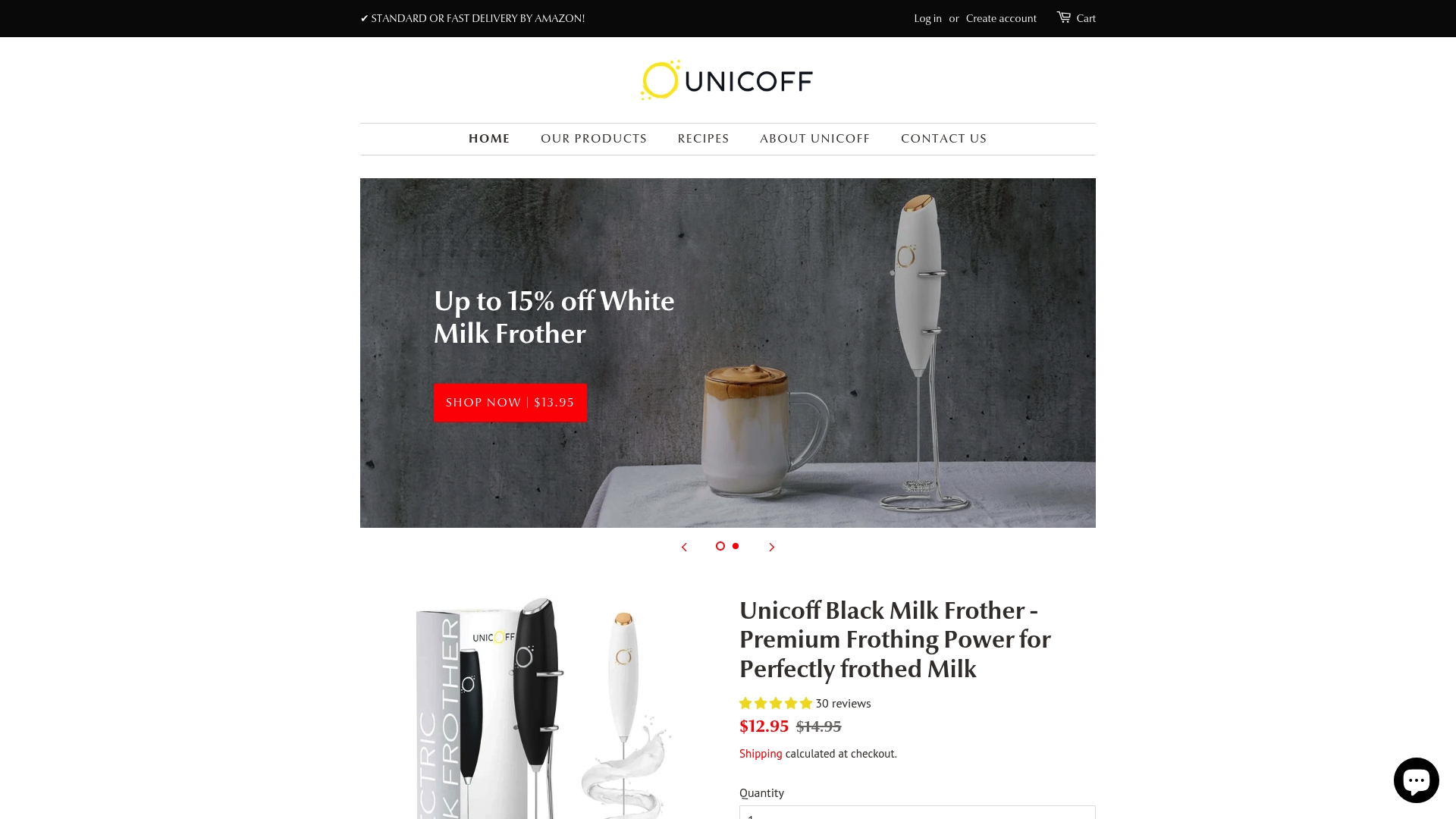Milk frothers might look like simple gadgets, but they are the secret behind that silky, café-style foam topping your favorite lattes and cappuccinos at home. Now get this. The right frother can create microbubbles so fine they actually change how your coffee tastes and feels. Most people think all milk froth is the same, but the science goes way deeper. The texture and protein chemistry inside your cup might matter even more than the coffee beans themselves.
Table of Contents
- What Are Milk Frothers And Their Types?
- Why Milk Frothing Matters For Coffee Quality
- How Milk Frothers Function: The Science Behind Frothing
- The Role Of Milk Texture In Coffee Beverages
- Choosing The Right Milk Frother For Your Needs
Quick Summary
| Takeaway | Explanation |
|---|---|
| Choose the right frother type | Understand the differences between manual, electric, and steam wand frothers to fit your coffee needs. |
| Master foam quality for flavor | Quality frothing transforms coffee’s taste, enhancing sweetness, and reducing bitterness through microfoam. |
| Temperature control is crucial | Precise heating allows proteins to denature properly, enhancing foam stability without compromising milk’s flavor. |
| Evaluate performance characteristics | Consider foam volume, bubble uniformity, and ease of cleaning when selecting a frother for optimal experience. |
| Invest time in practice | Improving frothing techniques can significantly elevate your coffee experience, making drinks more enjoyable. |
What Are Milk Frothers and Their Types?
Milk frothers are specialized kitchen tools designed to transform ordinary milk into a creamy, airy foam that elevates coffee beverages like cappuccinos, lattes, and macchiatos. These devices play a critical role in creating the luxurious texture and rich mouthfeel that coffee enthusiasts appreciate. Learn more about our professional milk frothers that can help you achieve barista-quality results at home.
The Science Behind Milk Frothing
At its core, milk frothing involves introducing air into milk proteins and fat molecules, creating a stable foam with microscopic bubbles. According to research from the Food Science Department, the protein structure in milk determines the quality and stability of the foam. Whole milk, with its higher fat content, typically produces richer, more stable foam compared to skim milk.
Types of Milk Frothers
Milk frothers come in several distinct varieties, each offering unique advantages for coffee preparation:
-
Manual Frothers: Handheld devices requiring physical movement, such as pump or whisk-style frothers. These are budget-friendly and provide good control over foam texture.
-
Electric Frothers: Automated devices that heat and froth milk with the push of a button. They offer consistent results and multiple temperature settings.
-
Steam Wand Frothers: Typically attached to espresso machines, these professional-grade tools use high-pressure steam to create microfoam with exceptional texture and temperature control.
Choosing the right milk frother depends on your specific coffee preparation needs, budget, and desired level of involvement in the frothing process.
Below is a comparison of the three main types of milk frothers, summarizing their operation method, benefits, and typical user suitability.
| Frother Type | Operation Method | Key Benefits | Ideal For |
|---|---|---|---|
| Manual Frother | Hand-powered (pump or whisk) | Budget-friendly, control over foam | Occasional home users |
| Electric Frother | Automated, heats and froths milk | Consistent results, easy operation | Everyday convenience seekers |
| Steam Wand Frother | Steam pressure via espresso machine | Professional texture, temperature control | Home baristas, enthusiasts |
| Whether you are a casual coffee drinker or a home barista seeking precision, there is a milk frother designed to enhance your brewing experience. |

Why Milk Frothing Matters for Coffee Quality
Milk frothing transforms an ordinary coffee beverage into an extraordinary sensory experience, elevating the drink from a simple caffeine delivery system to a complex culinary art form. The process of creating perfect milk foam goes far beyond aesthetic appeal, fundamentally influencing taste, temperature, and overall drinking pleasure.
Check out our professional milk foam makers designed to help you achieve barista-level results.
The Sensory Impact of Milk Foam
Properly frothed milk introduces multiple sensory dimensions to coffee. According to research from Louisiana State University, milk’s molecular composition dramatically affects its frothing potential. The intricate microfoam created during frothing generates a silky texture that softens coffee’s inherent bitterness, balances acidity, and creates a harmonious flavor profile. The tiny air bubbles trap heat, maintaining an optimal drinking temperature while providing a luxurious mouthfeel that distinguishes premium coffee beverages.
Critical Elements of High-Quality Milk Frothing
Successful milk frothing depends on several crucial factors that directly impact coffee quality:
-
Protein Structure: Milk proteins must be carefully manipulated to create stable, fine-textured foam that integrates seamlessly with espresso.
-
Temperature Control: Precise heating ensures proteins denature correctly without scalding, preserving milk’s natural sweetness and creating ideal foam consistency.
-
Bubble Size and Stability: Microfoam with consistently small, uniform bubbles provides a smoother, more integrated drinking experience compared to large, unstable foam.
Understanding these nuanced interactions between milk and coffee demonstrates why professional baristas and home enthusiasts invest significant effort in mastering milk frothing techniques.
This table highlights the key factors that influence milk frothing quality and their specific impacts on the final beverage experience.
| Critical Factor | Impact on Froth Quality | Result in Beverage Experience |
|---|---|---|
| Protein Structure | Determines stability and fineness of foam | Creates smooth, integrated foam |
| Temperature Control | Ensures proteins denature properly without scalding | Preserves sweetness, ideal foam texture |
| Bubble Size/Stability | Microbubbles create uniform, lasting foam | Smoother mouthfeel, consistent quality |
| The right approach transforms a simple drink into a sophisticated culinary experience that engages multiple sensory dimensions. |
How Milk Frothers Function: The Science Behind Frothing
Milk frothers operate through complex molecular interactions that transform liquid milk into a rich, creamy foam by strategically introducing and trapping air bubbles. This precise scientific process involves manipulating protein structures and creating a stable emulsion that dramatically enhances coffee beverages. Explore our handheld frothing technology designed to perfect this delicate process.
Molecular Mechanics of Milk Frothing
The science of milk frothing centers on protein denaturation and surface tension modification. According to research from Penn State University, milk contains two primary proteins crucial to foam formation: casein and whey. When mechanical agitation or heat is applied, these proteins unfold and realign, creating a network that stabilizes air bubbles. Whey proteins, particularly, play a critical role in forming and maintaining foam structure by creating elastic surface membranes around air bubbles.
Key Physicochemical Processes
Milk frothing involves several intricate physicochemical transformations that determine foam quality:
-
Protein Unfolding: Heat and mechanical action cause milk proteins to change their three-dimensional structure, exposing hydrophobic and hydrophilic regions.
-
Surface Tension Reduction: Proteins migrate to air bubble interfaces, lowering surface tension and creating stable, long-lasting foam structures.
-
Thermal Protein Interactions: Precise temperature control ensures optimal protein denaturation without compromising milk’s fundamental characteristics.
Understanding these microscopic interactions reveals why professional-grade milk frothers produce superior results compared to manual whisking. The controlled application of mechanical energy and temperature creates a scientifically engineered process that transforms ordinary milk into a luxurious, texture-rich foam perfect for elevating coffee experiences.
The Role of Milk Texture in Coffee Beverages
Milk texture transforms coffee from a simple caffeinated beverage into a sophisticated culinary experience, acting as a critical sensory component that influences taste, aroma, and overall drinking pleasure. The intricate interaction between milk and coffee creates a complex flavor profile that goes far beyond basic liquid combination. Discover professional latte artistry techniques to elevate your coffee preparation skills.
Sensory Dimensions of Milk Texture
According to research published in PubMed, milk addition fundamentally alters coffee’s chemical composition and sensory perception. The protein interactions between coffee compounds and milk proteins create nuanced flavor transformations. Microfoam, with its silky, velvety consistency, serves as more than just an aesthetic element. It introduces thermal insulation, moderates coffee’s inherent bitterness, and provides a luxurious mouthfeel that smooths out flavor intensity.
Molecular Impact on Flavor Perception
Milk texture influences coffee beverage characteristics through several critical mechanisms:
-
Flavor Modulation: Milk proteins bind with coffee’s polyphenols, reducing perceived bitterness and creating a more balanced taste profile.
-
Thermal Stability: Fine milk foam maintains optimal drinking temperature, preserving the delicate aromatic compounds that define coffee’s character.
-
Structural Complexity: The interaction between milk’s protein networks and coffee’s molecular structure generates a unique sensory experience that transcends individual ingredient properties.
Understanding milk texture reveals the sophisticated science behind seemingly simple coffee beverages. Each sip represents a carefully orchestrated interaction of molecular components, transforming raw ingredients into a harmonious, multi-dimensional drinking experience that engages multiple sensory pathways.

Choosing the Right Milk Frother for Your Needs
Selecting the ideal milk frother requires understanding your specific coffee preparation goals, lifestyle demands, and desired beverage complexity. This decision goes beyond simple kitchen equipment selection and involves evaluating personal brewing preferences, technical capabilities, and long-term performance expectations. Explore our comprehensive milk frother collection to find your perfect match.
Evaluating Frother Performance Characteristics
According to research published in Food Research International, milk frother selection significantly impacts foam quality and overall beverage experience. Professional-grade frothers distinguish themselves through precise temperature control, consistent foam texture, and mechanical efficiency. Key performance indicators include foam volume, bubble uniformity, heating speed, and ease of cleaning.
Critical Selection Criteria
Choosing the right milk frother involves comprehensive assessment across multiple dimensions:
-
Usage Frequency: Frequent home baristas require more robust devices with higher durability and faster operational cycles.
-
Beverage Diversity: Consider frothers capable of producing varied foam textures suitable for different coffee styles like cappuccinos, lattes, and macchiatos.
-
Budget and Investment: Balance initial purchase cost with long-term performance, maintenance requirements, and potential replacement expenses.
Understanding these nuanced selection criteria transforms milk frother purchasing from a simple transaction into a strategic investment in your daily coffee experience. The right device becomes an extension of your brewing technique, elevating each cup from ordinary to extraordinary.
Discover Professional Froth at Home with Unicoff
Struggling to achieve that creamy, luxurious foam that elevates your morning coffee? This article explored the science behind perfect milk froth, the importance of stable microfoam, and how specialized tools influence your coffee experience. At Unicoff, we understand how frustrating it can be when your homemade lattes fall flat or lack that silky café texture you crave. Our curated selection addresses all the common pain points—temperature control, foam consistency, and ease of use—so you can enjoy barista-quality results every day.
Find the Best Milk Frother for Your Home

Ready to transform your daily coffee routine? Visit Unicoff.com to browse our top-rated milk frothers, featuring a variety of stylish options and exclusive deals. Choose a model backed by real customer reviews and fast, reliable shipping. Elevate your beverage experience and taste the difference professional frothing makes—shop now and enjoy a new level of coffee enjoyment.
Frequently Asked Questions
What is the purpose of a milk frother in coffee preparation?
Milk frothers are designed to create creamy, airy foam from milk, enhancing the texture and mouthfeel of coffee beverages like cappuccinos, lattes, and macchiatos, ultimately elevating the overall coffee experience.
What are the different types of milk frothers available?
There are three main types of milk frothers: manual frothers, which require physical effort; electric frothers, which automate the frothing process; and steam wand frothers, which are typically attached to espresso machines and use steam to create microfoam.
How does frothing milk affect the flavor of coffee?
Frothing milk introduces air bubbles that create microfoam, which moderates coffee’s bitterness, balances acidity, and contributes to a creamy mouthfeel, significantly enhancing the overall flavor profile of the beverage.
What factors influence the quality of frothed milk?
Key factors include the protein structure of the milk, temperature control during frothing, and the size and stability of the air bubbles formed in the foam, all of which impact the final texture and quality of the milk froth.
